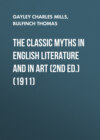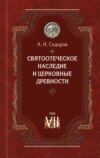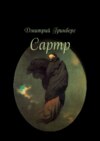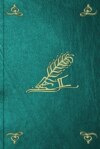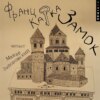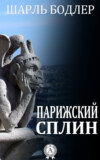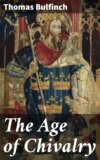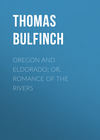Читать книгу: «The Classic Myths in English Literature and in Art (2nd ed.) (1911)», страница 37
In Art. The terra-cotta relief (Fig. 130, text) in the British Museum; the relief from Naples, now in Vienna (Fig. 131). Figs. 132 and 133 as explained in text. Also the splendid Vengeance of Medea in the Louvre; relief on a Roman sarcophagus.
168. Textual.
Table K. The Descendants of Ætolus (Son of Endymion)

Also, in general, Table I.
For Calydon, see Index. The Arcadian Atalanta was descended from the Arcas who was son of Jupiter and Callisto. (See Table D.)
Interpretative. Atalanta is the "unwearied maiden." She is the human counterpart of the huntress Diana. The story has of course been allegorically explained, but it bears numerous marks of local and historic origin.
Illustrative. Swinburne, Atalanta in Calydon; Margaret J. Preston, The Quenched Branch; Shakespeare, 2 Henry IV, II, ii; 2 Henry VI, I, i.
In Art. The Meleager (sculpture), in the Vatican; the Roman reliefs as in text. The original of Fig. 135 is in the Louvre.
169. The Merope story has been dramatized by Maffei (1713), Voltaire (1743), Alfieri (1783), and by others.
170-171. C. S. Calverley's The Sons of Leda, from Theocritus. Leda: Spenser, Prothalamion; Landor, Loss of Memory. Talus: the iron attendant of Artegal, Spenser, Faerie Queene, 5, 1, 12.
172. The Descendants of Minos I. (See also Table D.)
Table L

Interpretative. Discrimination between Minos I and Minos II is made in the text, but is rarely observed. Minos, according to Preller, is the solar king and hero of Crete; his wife, Pasiphaë, is the moon (who was worshiped in Crete under the form of a cow); and the Minotaur is the lord of the starry heavens which are his labyrinth. Others make Pasiphaë, whose name means shiner upon all, the bright heaven; and Minos (in accordance with his name, the Man, par excellence), the thinker and measurer. A lawgiver on earth, the Homeric Minos readily becomes a judge in Hades. Various fanciful interpretations, such as storm cloud, sun, etc., are given of the bull. Cox explains the Minotaur as night, devouring all things. The tribute from Athens may suggest some early suzerainty in politics and religion exercised by Crete over neighboring lands. For Mæander, see Pope, Rape of the Lock, 5, 65; Dunciad, 1, 64; 3, 55.
173. Interpretative. Dædalus is a representative of the earliest technical skill, especially in wood-cutting, carving, and the plastic arts used for industrial purposes. His flight from one land to another signifies the introduction of inventions into the countries concerned. The fall of Icarus was probably invented to explain the name of the Icarian Sea.
Illustrative. Dædalus: Chaucer, Hous of Fame, 409. Icarus: Shakespeare, 1 Henry VI, IV, vi; IV, vii; 3 Henry VI, V, vi; poem on Icarus by Bayard Taylor; travesty by J. G. Saxe.
In Art. Sculpture: Fig. 138, in text: Villa Albani, Rome; Canova's Dædalus and Icarus; painting by J. M. Vien; also by A. Pisano (Campanile, Florence).
174. The descendants of Erichthonius are as follows:
Table M

Cecrops (see 65). According to one tradition, Cecrops was autochthonous and had one son, Erysichthon, who died without issue, and three daughters, Herse, Aglauros, and Pandrosos (personifications of Dew and its vivifying influences). According to another, he was of the line of Erichthonius, being either a son of Pandion I, or a son of Erechtheus and a grandson of Pandion I. Apollodorus makes him father of Pandion II. He was regarded as founder of the worship of Athene and of various civic institutions. He is probably a hero of the Pelasgian race.
Ion. According to one tradition, the race of Erechtheus became extinct, save for Ion, a son of Apollo and Creüsa, daughter of Erechtheus. This son, having been removed at birth, was brought up in Apollo's temple at Delphi, and, in accordance with the oracle of Apollo, afterwards adopted by Creüsa and her husband Xuthus (see the Ion of Euripides). Ion founded the new dynasty of Athens. But, according to Pausanias and Apollodorus, the dynasty of Erechtheus was continued by Ægeus, who was either a son, or an adopted son, of Pandion II. By Æthra he became father of Theseus, in whose veins flowed, therefore, the blood of Pelops and of Erichthonius.
Interpretative. The story of Philomela was probably invented to account for the sad song of the nightingale. With her the swallow is associated as another much loved bird of spring. Occasionally Procne is spoken of as the nightingale, and Philomela as the swallow, and Tereus as taking the form of a red-crested hoopoe.
Illustrative. Chaucer, Legende of Good Women (Philomene of Athens); Milton, Il Penseroso; Richard Barnfield, Song, "As it fell upon a day"; Thomson, Hymn on the Seasons; Swinburne, Itylus; Oscar Wilde, The Burden of Itys; Sir Thomas Noon Talfourd's drama, Ion.
176-181. Trœzen: in Argolis. According to some the Amazonian wife of Theseus was Hippolyta, but her Hercules had already killed. Theseus is said to have united the several tribes of Attica into one state, of which Athens was the capital. In commemoration of this important event, he instituted the festival of Panathenæa, in honor of Athene, the patron deity of Athens. This festival differed from the other Grecian games chiefly in two particulars. It was peculiar to the Athenians, and its chief feature was a solemn procession in which the Peplus, or sacred robe of Athene, was carried to the Parthenon, and left on or before the statue of the goddess. The Peplus was covered with embroidery, worked by select virgins of the noblest families in Athens. The procession consisted of persons of all ages and both sexes. The old men carried olive branches in their hands, and the young men bore arms. The young women carried baskets on their heads, containing the sacred utensils, cakes, and all things necessary for the sacrifices. The procession formed the subject of the bas-reliefs which embellished the frieze of the temple of the Parthenon. A considerable portion of these sculptures is now in the British Museum among those known as the "Elgin Marbles." We may mention here the other celebrated national games of the Greeks. The first and most distinguished were the Olympic, founded, it was said, by Zeus himself. They were celebrated at Olympia in Elis. Vast numbers of spectators flocked to them from every part of Greece, and from Asia, Africa, and Sicily. They were repeated every fifth year in midsummer, and continued five days. They gave rise to the custom of reckoning time and dating events by Olympiads. The first Olympiad is generally considered as beginning with the year 776 B.C. The Pythian games were celebrated in the vicinity of Delphi, the Isthmian on the Corinthian isthmus, the Nemean at Nemea, a city of Argolis. The exercises in these games were chariot-racing, running, leaping, wrestling, throwing the quoit, hurling the javelin, and boxing. Besides these exercises of bodily strength and agility, there were contests in music, poetry, and eloquence. Thus these games furnished poets, musicians, and authors the best opportunities to present their productions to the public, and the fame of the victors was diffused far and wide.
Interpretative. Theseus is the Attic counterpart of Hercules, not so significant in moral character, but eminent for numerous similar labors, and preëminent as the mythical statesman of Athens. His story may, with the usual perilous facility, be explained as a solar myth. Periphetes may be a storm cloud with its thunderbolts; the Marathonian Bull and the Minotaur may be forms of the power of darkness hidden in the starry labyrinth of heaven. Like Hercules, Theseus fights with the Amazons (clouds, we may suppose, in some form or other), and, like him, he descends to the underworld. Ariadne may be another twilight-sweetheart of the sun, and, like Medea and Dejanira, she must be deserted. She is either the "well-pleasing" or the "saintly." She was, presumably, a local nature-goddess of Naxos and Crete, who, in process of time, like Medea, sank to the condition of a heroine. Probably from her goddess-existence the marriage with Bacchus survived, to be incorporated later with the Attic myth of Theseus. As the female semblance of Bacchus, she appears to have been a promoter of vegetation; and, like Proserpina, she alternated between the joy of spring and the melancholy of winter. By some she is considered to be connected with star-worship as a moon-goddess.
Illustrative. Chaucer, The Knight's Tale (for Theseus and Ypolita); The Hous of Fame, 407, and the Legende of Good Women, 1884, for Ariadne; Shakespeare, Two Gentlemen of Verona, IV, i; Midsummer Night's Dream, II, ii (Hippolyta and Theseus); Shakespeare and Fletcher, Two Noble Kinsmen. In Beaumont and Fletcher's Maid's Tragedy, II, ii, a tapestry is ordered to be worked illustrating Theseus' desertion of Ariadne. Landor, To Joseph Ablett, "Bacchus is coming down to drink to Ariadne's love"; Landor, Theseus, and Hippolyta; Mrs. Browning, Paraphrase on Nonnus (Bacchus and Ariadne), Paraphrase on Hesiod; Sir Theodore Martin, Catullus, LXIV. Other poems: B. W. Procter, On the Statue of Theseus; Frederick Tennyson, Ariadne (Daphne and Other Poems); Mrs. Hemans, The Shade of Theseus; R. S. Ross, Ariadne in Naxos; J. S. Blackie, Ariadne; W. M. W. Call, Ariadne; Mrs. H. H. Jackson, Ariadne's Farewell. Phædra and Hippolytus: The Hippolytus of Euripides; Swinburne, Phædra; Browning, Artemis Prologizes; M. P. Fitzgerald, The Crowned Hippolytus; A. Mary F. Robinson, The Crowned Hippolytus; L. Morris, Phædra (Epic of Hades). On Cecrops: J. S. Blackie, The Naming of Athens; Erechtheus, by A. C. Swinburne.
In Art. Theseus: the original of Fig. 140, text is in the Hermitage, St. Petersburg; of Fig. 141 in the Naples Museum. The Battle with the Amazons frequently recurs in ancient sculpture. The sleeping Ariadne, of the Vatican, Fig. 142, text. Also the Revels as in text, Fig. 144. Modern Sculpture: the Theseus of Canova (Volksgarten, Vienna); the Ariadne of Dannecker. Paintings: Tintoretto's Ariadne and Bacchus; Teschendorff's Ariadne; Titian's Bacchus and Ariadne.
182-189. The Royal Family of Thebes.
Table N

Illustrative. Œdipus: Plumptre's translation of Œdipus the King, Œdipus Coloneus, and Antigone; Shelley, Swellfoot the Tyrant; E. Fitzgerald, The Downfall and Death of King Œdipus; Sir F. H. Doyle, Œdipus Tyrannus; Aubrey De Vere, Antigone; Emerson, The Sphinx; W. B. Scott, The Sphinx; M. Arnold, Fragment of an "Antigone." Tiresias: by Swinburne, Tennyson, and Thomas Woolner.
In Art. Ancient: Œdipus and the Sphinx (in Monuments Inédits, Rome and Paris, 1839-1878). Modern paintings: Teschendorff's Œdipus and Antigone, Antigone and Ismene, and Antigone; Œdipus and the Sphinx, by J. D. A. Ingres; The Sphinx, by D. G. Rossetti.
Of the stories told in these and the following sections no systematic, allegorical, or physical interpretations are here given, because (1) the general method followed by the unravelers of myth has already been sufficiently illustrated; (2) the attempt to force symbolic conceptions into the longer folk-stories, or into the artistic myths and epics of any country, is historically unwarranted and, in practice, is only too often capricious; (3) the effort to interpret such stories as the Iliad and the Odyssey must result in destroying those elements of unconscious simplicity and romantic vigor that characterize the early products of the creative imagination.
190-194. Houses concerned in the Trojan War.
Table O



Castor and Pollux are called sometimes Dioscuri (sons of Jove), sometimes Tyndaridæ (sons of Tyndareus). Helen is frequently called Tyndaris, daughter of Tyndareus.



195. On the Iliad and on Troy: Keats, Sonnet on Chapman's Homer; Milton, Paradise Lost, 1, 578; 9, 16; Il Penseroso, 100; Hartley Coleridge, Sonnet on Homer; T. B. Aldrich, Pillared Arch and Sculptured Tower; the Sonnets of Lang and Myers prefixed to Lang, Leaf, and Myers' translation of the Iliad. On the Judgment of Paris: George Peele, Arraignment of Paris; James Beattie, Judgment of Paris; Tennyson, Dream of Fair Women; J. S. Blackie, Judgment of Paris. See, for allusions, Shakespeare, All's Well that Ends Well, I, ii, iii; Henry V, II, iv; Troilus and Cressida, I, i; II, ii; III, i; Romeo and Juliet, I, ii; II, iv; IV, i; V, iii. On Helen: A. Lang, Helen of Troy, and his translation of Theocritus, Idyl XVIII; Landor, Menelaüs and Helen; John Todhunter, Helena in Troas; G. P. Lathrop, Helen at the Loom (Atlantic Monthly, Vol. 32, 1873). See Shakespeare, Midsummer Night's Dream, I, i; III, ii; IV, i; All's Well that Ends Well, I, i, iii; II, ii; Romeo and Juliet, II, iv; Troilus and Cressida, II, ii; Marlowe, Faustus (Helen appears before Faust).
In Art. Homer: the sketch by Raphael (in the Museum, Venice). Paris and Helen. Paintings: Helen of Troy, Sir Frederick Leighton; Paris and Helen, by David; The Judgment of Paris, by Rubens; by Watteau. Sculpture: Canova's Paris. Crayons: D. G. Rossetti's Helen; see also Fig. 150, as in text (ancient relief, Naples).
196. Iphigenia and Agamemnon. Sometimes, in accordance with Goethe's practice, the name Tauris is given to the land of the Tauri. To be correct one should say, "Iphigenia among the Tauri," or "Taurians." (See Index.) Iphigenia and Agamemnon by W. S. Landor; also his Shades of Agamemnon and Iphigenia; Dryden, Cymon and Iphigenia; Richard Garnett, Iphigenia in Delphi; Sir Edwin Arnold, Iphigenia; W. B. Scott, Iphigenia at Aulis. Any translations of Goethe's Iphigenia in Tauris, and of Euripides' Iphigenia in Aulis and Among the Tauri; also of Æschylus' Agamemnon, – such as those by Milman, Anna Swanwick, Plumptre, E. A. Morshead, J. S. Blackie, E. Fitzgerald, and Robert Browning. For Agamemnon, see Shakespeare, Troilus and Cressida, I, iii; II, i, iii; III, iii; IV, v; V, i; and James Thomson, Agamemnon (a drama). The Troilus and Cressida story is not found in Greek and Latin classics. Shakespeare follows Chaucer's Troilus and Criseyde, which is based upon the Filostrato and the Filocolo of Boccaccio. Pandarus: the character of this name, uncle of Cressida, to be found in Lydgate, Chaucer's Troilus and Criseyde, and Shakespeare's play of the same title, enjoys an unsavory reputation for which medieval romance is responsible. On Menelaüs, see notes to Helen and Agamemnon.
In Art. Iphigenia. Paintings: Fig. 152, text (Museum, Naples); E. Hübner; William Kaulbach; E. Teschendorff.
199. Achilles. Chaucer, Hous of Fame, 398; Dethe of Blaunche, 329; Landor, Peleus and Thetis; Robert Bridges, Achilles in Scyros; Sir Theodore Martin, translation of Catullus, LXIV; translation by C. M. Gayley as quoted in text. See also Shakespeare, Troilus and Cressida; 2 Henry VI, V, i; Love's Labour's Lost, V, ii; Milton, Paradise Lost, 9, 15.
In Art. In general, Figs. 151, 153, 155-156, 159-162, in text; Wiertz, Fight for the Body of Achilles (Wiertz Museum, Brussels); Burne-Jones, The Feast of Peleus (picture).
204. Ajax. Plumptre, Ajax of Sophocles; Shakespeare, Troilus and Cressida, Love's Labour's Lost, IV, iii; V, ii; Taming of the Shrew, III, i; Antony and Cleopatra, IV, ii; King Lear, II, ii; Cymbeline, IV, ii; George Crabbe, The Village.
In Art. The ancient sculpture, Ajax (or Menelaüs) of the Vatican. Modern sculpture, The Ajax of Canova. Flaxman's outline drawings for the Iliad.
207. Hector and Andromache. Mrs. Browning, Hector and Andromache, a paraphrase of Homer; C. T. Brooks, Schiller's Parting of Hector and Andromache. See also Shakespeare, Troilus and Cressida; Love's Labour's Lost, V, ii; 2 Henry IV, II, iv; Antony and Cleopatra, IV, viii.
In Art. Flaxman's outline sketches of the Fight for the Body of Patroclus, Hector dragged by Achilles, Priam supplicating Achilles, Hector's Funeral, Andromache fainting on the Walls of Troy; Canova's Hector (sculpture); Thorwaldsen's Hector and Andromache (relief) (Fig. 154, text). Hector, Ajax, Paris, Æneas, Patroclus, Teucer, etc., among the Ægina Marbles (Glyptothek, Munich). The Pasquino group (Fig. 158, in text) is from a copy in the Pitti, Florence.
216. Priam and Hecuba. The translations of Euripides' Hecuba and Troades; Shakespeare, Troilus and Cressida; Coriolanus, I, iii; Cymbeline, IV, ii; Hamlet, II, ii; 2 Henry IV, I, i.
219-220. Polyxena. W. S. Landor, The Espousals of Polyxena. Philoctetes: translation of Sophocles by Plumptre; sonnet by Wordsworth; drama by Lord de Tabley.
221. Œnone. See A. Lang, Helen of Troy; W. Morris, Death of Paris (Earthly Paradise); Landor, Corythos (son of Œnone), the Death of Paris, and Œnone, Tennyson, Œnone, also the Death of Œnone, which is not so good.
The pathetic story of the death of Corythus, the son of Œnone and Paris, at the hands of his father, who was jealous of Helen's tenderness toward the youth, is a later myth.
223. Sinon. Shakespeare, 3 Henry VI, III, ii; Cymbeline, III, iv; Titus Andronicus, V, iii.
224. Laocoön. L. Morris, in The Epic of Hades. See Frothingham's translation of Lessing's Laocoön (a most important discussion of the Laocoön group and of principles of æsthetics). See also Swift's Description of a City Shower.
In Art. The original of the celebrated group (statuary) of Laocoön and his children in the embrace of the serpents is in the Vatican in Rome. (See text, opp. p. 310.)
226. Cassandra. Chaucer, Troilus and Criseyde; Dethe of Blaunche, 1246. Poems by W. M. Praed and D. G. Rossetti. See Troilus and Cressida, I, i; II, ii; V, iii; Lord Lytton's translation of Schiller's Cassandra.
In Art. The Cassandra of Dante Gabriel Rossetti (in ink).
228-230. Electra and Orestes. Translations of the Electra of Sophocles, the Libation-pourers and the Eumenides of Æschylus, by Plumptre; and of the Orestes and Electra of Euripides, by Wodhull. Lord de Tabley, Orestes (a drama); Byron, Childe Harold, 4; Milton, sonnet, "The repeated air Of sad Electra's poet," etc.
In Art. Græco-Roman sculpture: Fig. 169, in text, Orestes and Pylades find Iphigenia among the Taurians. Pompeian Fresco; Orestes and Electra (Villa Ludovisi, Rome); Orestes and Electra (National Museum, Naples). Vase-paintings: Figs. 167-168 in text; also Orestes slaying Ægisthus; Orestes at Delphi; Purification of Orestes. Modern paintings: Electra, by Teschendorff and by Seifert.
Clytemnestra, The Death of, by W. S. Landor; Clytemnestra, by L. Morris, in The Epic of Hades.
Troy: Byron, in his Bride of Abydos, thus describes the appearance of the deserted scene where once stood Troy:
The winds are high, and Helle's tide
Rolls darkly heaving to the main;
And Night's descending shadows hide
That field with blood bedew'd in vain,
The desert of old Priam's pride;
The tombs, sole relics of his reign,
All – save immortal dreams that could beguile
The blind old man of Scio's rocky isle!
On Troy the following references will be valuable: H. W. Acland, The Plains of Troy, 2 vols. (London, 1839); H. Schliemann, Troy and its Remains (London, 1875); Ilios (London, 1881); Troja, results of latest researches on the site of Homer's Troy (London, 1882); W. J. Armstrong, Atlantic Monthly, Vol. 33, p. 173 (1874), Over Ilium and Ida; R. C. Jebb, Jour. Hellenic Studies, Vol. 2, p. 7, Homeric and Hellenic Ilium; Fortn. Review, N. S. Vol. 35, p. 4331 (1884), Homeric Troy.
231-244. The Odyssey: Lang, Sonnet, "As one that for a weary space has lain," prefixed to Butcher and Lang's Odyssey. Translations by W. Morris, G. H. Palmer, Chapman, Bryant, Pope. Ulysses: Tennyson; Landor, The Last of Ulysses. See also Shakespeare, Troilus and Cressida; 3 Henry VI, III, ii; Coriolanus, I, iii; Milton, Paradise Lost, 2, 1019; Comus, 637; R. Buchanan, Cloudland; Pope, Rape of the Lock, 4, 182; Stephen Phillips, Ulysses; Robert Bridges, The Return of Ulysses; R. C. Rogers, Odysseus at the Mast, Blind Polyphemus, Argus.
In Art. Statuettes, vase-paintings, and reliefs as in text, Figs. 170-180; also Ulysses summoning Tiresias (in Monuments Inédits, Rome and Paris, 1839-1878); Meeting with Nausicaa (Gerhard's vase pictures); outline drawings of Ulysses weeping at the song of Demodocus, boring out the eye of Polyphemus, Ulysses killing the suitors, Mercury conducting the souls of the suitors, Ulysses and his dog, etc., by Flaxman.
Penelope: Poems by R. Buchanan, E. C. Stedman, and W. S. Landor. In ancient sculpture, the Penelope in the Vatican. Modern painting by C. F. Marchal. In crayons by D. G. Rossetti.
Circe: M. Arnold, The Strayed Reveller; Hood, Lycus, the Centaur; D. G. Rossetti, The Wine of Circe; Saxe, The Spell of Circe. See Shakespeare, Comedy of Errors, V, i; 1 Henry VI, V, iii; Milton, Comus, 50, 153, 253, 522; Pope, Satire 8, 166; Cowper, Progress of Error; O. W. Holmes, Metrical Essay; Keats, Endymion, "I sue not for my happy crown again," etc. Circe and the Companions of Ulysses, a painting by Briton Rivière. Circe, in crayons.
On Sirens and Scylla see C. 50-52; S. Daniel, Ulysses and the Siren; Lowell, The Sirens. Scylla and Charybdis have become proverbial to denote opposite dangers besetting one's course. Siren, in crayons; Sea-Spell, in oil, D. G. Rossetti.
Calypso: Pope, Moral Essays, 2, 45; poem by Edgar Fawcett (Putnam's Mag., 14, 1869). Fénelon, in his romance of Telemachus, has given us the adventures of the son of Ulysses in search of his father. Among other places which he visited, following on his father's footsteps, was Calypso's isle; as in the former case, the goddess tried every art to keep the youth with her, and offered to share her immortality with him. But Minerva, who, in the shape of Mentor, accompanied him and governed all his movements, made him repel her allurements. Finally, when no other means of escape could be found, the two friends leaped from a cliff into the sea and swam to a vessel which lay becalmed offshore. Byron alludes to this leap of Telemachus and Mentor in the stanza of Childe Harold beginning "But not in silence pass Calypso's isles" (2, 29). Calypso's isle is said to be Goza.
Homer's description of the ships of the Phæacians has been thought to look like an anticipation of the wonders of modern steam navigation. See the address of Alcinoüs to Ulysses, promising "wondrous ships, self-moved, instinct with mind," etc. (Odyssey, 8).
Lord Carlisle, in his Diary in the Turkish and Greek Waters, thus speaks of Corfu, which he considers to be the ancient Phæacian island:
"The sites explain the Odyssey. The temple of the sea-god could not have been more fitly placed, upon a grassy platform of the most elastic turf, on the brow of a crag commanding harbor, and channel, and ocean. Just at the entrance of the inner harbor there is a picturesque rock with a small convent perched upon it, which by one legend is the transformed pinnace of Ulysses.
"Almost the only river in the island is just at the proper distance from the probable site of the city and palace of the king, to justify the princess Nausicaa having had resort to her chariot and to luncheon when she went with the maidens of the court to wash their garments."
245-254. Poems: Tennyson, To Virgil, of which a few stanzas are given in the text; R. C. Rogers, Virgil's Tomb. Æneas and Anchises: Chaucer, Hous of Fame, 165; 140-470 (pictures of Troy); Shakespeare, Troilus and Cressida; Tempest, II, i; 2 Henry VI, V, ii; Julius Cæsar, I, ii; Antony and Cleopatra, IV, ii; Hamlet, II, ii; Waller, Panegyric to the Lord-Protector (The Stilling of Neptune's Storm).
Dido: Chaucer, Legende of Good Women, 923; Sir Thomas Wyatt, The Song of Iopas (unfinished); Marlowe, Tragedy of Dido, Queen of Carthage; Shakespeare, Antony and Cleopatra, IV, xii; Titus Andronicus, II, iii; Hamlet, II, ii. Palinurus: see Scott's Marmion, Introd. to Canto I (with reference to the death of William Pitt).
The Sibyl. The following legend of the Sibyl is fixed at a later date. In the reign of one of the Tarquins there appeared before the king a woman who offered him nine books for sale. The king refused to purchase them, whereupon the woman went away and burned three of the books, and returning offered the remaining books for the same price she had asked for the nine. The king again rejected them; but when the woman, after burning three books more, returned and asked for the three remaining the same price which she had before asked for the nine, his curiosity was excited, and he purchased the books. They were found to contain the destinies of the Roman state. They were kept in the temple of Jupiter Capitolinus, preserved in a stone chest, and allowed to be inspected only by especial officers appointed for that duty, who on great occasions consulted them and interpreted their oracles to the people.
There were various Sibyls; but the Cumæan Sibyl, of whom Ovid and Virgil write, is the most celebrated of them. Ovid's story of her life protracted to one thousand years may be intended to represent the various Sibyls as being only reappearances of one and the same individual.
Illustrative. Young, in the Night Thoughts, alludes to the Sibyl. See also Shakespeare, 1 Henry VI, II, ii; Othello, III, iv.
In Art. Figs. 181-183, in text. The Virgil of Raphael (drawing in the Museum, Venice); the Æneas of the Ægina Marbles (Glyptothek, Munich). P. Guérin's painting, Æneas at the Court of Dido; Raphael, Dido; Turner, Dido building Carthage. The Sibyls in Michelangelo's frescoes in the Sistine Chapel, Rome; the Cumæan Sibyl of Domenichino; Elihu Vedder's Cumæan Sibyl.
255-257. Rhadamanthus: E. W. Gosse, The Island of the Blest. Tantalus: Cowper, The Progress of Error; L. Morris, Epic of Hades; W. W. Story, Tantalus. Ixion: poem by Browning in Jocoseria. See Pope, St. Cecilia's Day, 67; Rape of the Lock, 2, 133. Sisyphus: Lord Lytton, Death and Sisyphus; L. Morris, in The Epic of Hades.
The teachings of Anchises to Æneas, respecting the nature of the human soul, were in conformity with the doctrines of the Pythagoreans. Pythagoras (born about 540 B.C.) was a native of the island of Samos, but passed the chief portion of his life at Crotona in Italy. He is therefore sometimes called "the Samian," and sometimes "the philosopher of Crotona." When young he traveled extensively and is said to have visited Egypt, where he was instructed by the priests, and afterwards to have journeyed to the East, where he visited the Persian and Chaldean Magi, and the Brahmins of India. He established himself at Crotona, and enjoined sobriety, temperance, simplicity, and silence upon his throngs of disciples. Ipse dixit (Pythagoras said so) was to be held by them as sufficient proof of anything. Only advanced pupils might question. Pythagoras considered numbers as the essence and principle of all things, and attributed to them a real and distinct existence; so that, in his view, they were the elements out of which the universe was constructed.
As the numbers proceed from the monad or unit, so he regarded the pure and simple essence of the Deity as the source of all the forms of nature. Gods, demons, and heroes are emanations of the Supreme, and there is a fourth emanation, the human soul. This is immortal, and when freed from the fetters of the body, passes to the habitation of the dead, where it remains till it returns to the world, to dwell in some other human or animal body; at last, when sufficiently purified, it returns to the source from which it proceeded. This doctrine of the transmigration of souls (metempsychosis), which was originally Egyptian and connected with the doctrine of reward and punishment of human actions, was the chief reason why the Pythagoreans killed no animals. Ovid represents Pythagoras saying that in the time of the Trojan War he was Euphorbus, the son of Panthus, and fell by the spear of Menelaüs. Lately, he said, he had recognized his shield hanging among the trophies in the Temple of Juno at Argos.
On Metempsychosis, see the essay in the Spectator (No. 343) on the Transmigration of Souls; Shakespeare, Merchant of Venice (Gratiano to Shylock).
Harmony of the Spheres. The relation of the notes of the musical scale to numbers, whereby harmony results from proportional vibrations of sound, and discord from the reverse, led Pythagoras to apply the word harmony to the visible creation, meaning by it the just adaptation of parts to each other. This is the idea which Dryden expresses in the beginning of his song for St. Cecilia's Day, "From harmony, from heavenly harmony, This everlasting frame began."
In the center of the universe (as Pythagoras taught) there was a central fire, the principle of life. The central fire was surrounded by the earth, the moon, the sun, and the five planets. The distances of the various heavenly bodies from one another were conceived to correspond to the proportions of the musical scale. See Merchant of Venice, Act V (Lorenzo and Jessica), for the Music of the Spheres; also Milton, Hymn on the Nativity. See Longfellow's Verses to a Child, and Occultation of Orion, for Pythagoras as inventor of the lyre.
260. Camilla. Pope, illustrating the rule that "the sound should be an echo to the sense," says:
When Ajax strives some rock's vast weight to throw,
The line, too, labors and the words move slow;
Not so when swift Camilla scours the plain,
Flies o'er th' unbending corn, or skims along the main.
Essay on Criticism.
268-281. On Norse mythology, see R. B. Anderson, Norse Mythology, or the Religion of our Forefathers (Chicago, 1875); Anderson, Horn's Scandinavian Literature (Chicago, S. C. Griggs & Co., 1884); Dasent, Popular Tales from the Norse (transl. from P. C. Asbjörnsen, New York, 1859); Thorpe's translation of Sæmund's Edda, 2 vols. (London, 1866); Icelandic Poetry or Edda of Sæmund, transl. into English verse (Bristol, A. S. Cottle, 1797); Augusta Larned, Tales from the Norse Grandmother (New York, 1881); H. W. Mabie, Norse Stories (Boston, 1882). A critical edition of the Elder Edda is Sophus Bugge's (Christiania, 1867). The Younger Edda: Edda Snorra Sturlasonar, 2 vols. (Hafniae, 1848-1852); by Thorleif Jonsson (Copenhagen, 1875); Translation: Anderson's Younger Edda (Chicago, S. C. Griggs & Co., 1880) (see references at foot of pp. 458-461 and in C. 282). Illustrative poems: Gray, Ode on the Descent of Odin, Ode on the Fatal Sisters; Matthew Arnold, Balder Dead; Longfellow, Tegnér's Drapa, on Balder's Death; William Morris, The Funeral of Balder, in The Lovers of Gudrun (Earthly Paradise); Robert Buchanan, Balder the Beautiful; W. M. W. Call, Balder; and Thor. Sydney Dobell's Balder does not rehearse the Norse myth. It is a poem dealing with the spiritual maladies of the time, excellent in parts, but confused and uneven. Longfellow's Saga of King Olaf (the Musician's Tale, Wayside Inn) is from the Heimskriṅgla, or Book of Stories of the Kings, edited by Snorri Sturlason. Many of the cantos of the Saga throw light on Norse mythology. See also the Hon. Roden Noël's Ragnarok (in the Modern Faust), for an ethical modification of the ancient theme.

